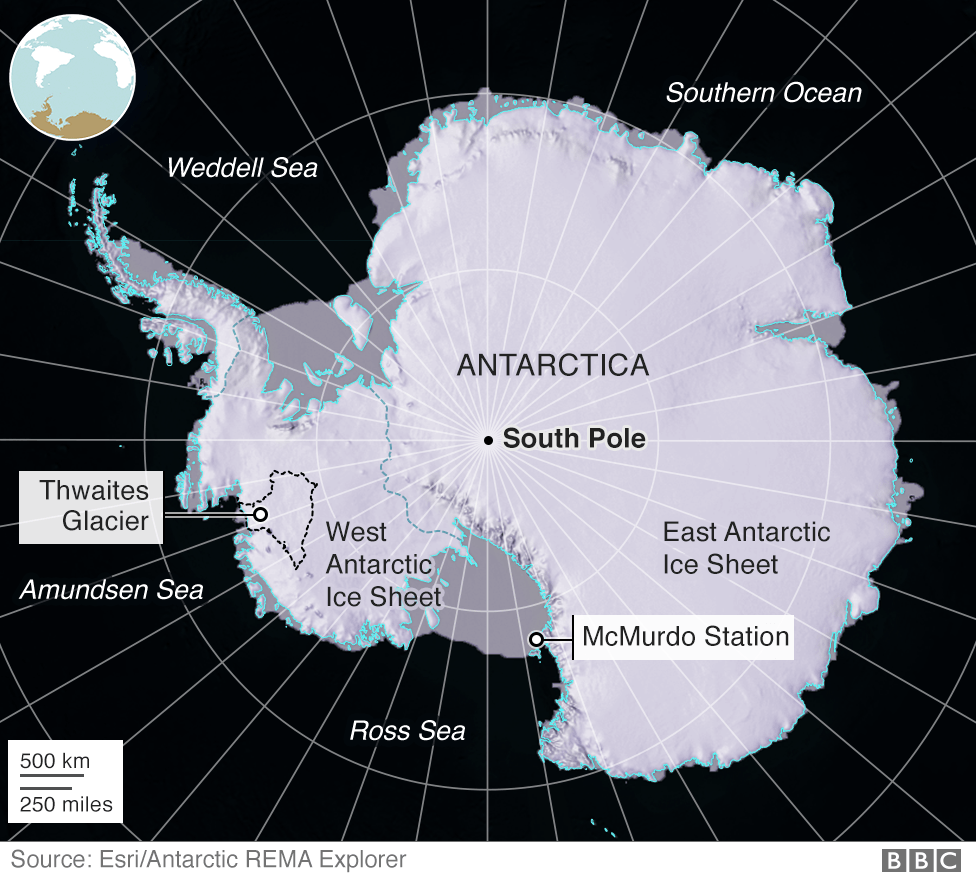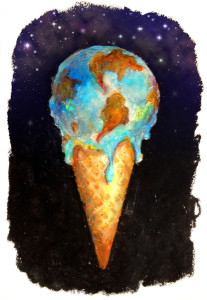 (Illustration: ‘Antarctica,’ Esri/Antarctica REMA Explorer, and found at the BBC).
(Illustration: ‘Antarctica,’ Esri/Antarctica REMA Explorer, and found at the BBC).
In the press of daily activities, both in the ever-shitty news cycle and most-likey within each of our lives, the wondrous COP26 climate conference is far-gone and its subject matter plastered onto a back burner — how to survive the holidays with a resurging coronavirus might be a more-immediate problem than rising sea levels.
Understandable, and terrifying as there will always be something ahead of climate change on the list of items to be most worried about, and until it’s time.
And that could be way-sooner than any time later.
In the context of time, one of the major problems of climate change research is a goodly-portion of the latest studies have discovered climate shit is occurring faster than originally figured (in studies maybe decades ago), and the really bad shit coming with a heating world environment might be here before we know it.
Major-notable example from June 2019 (Reuters): ‘Permafrost at outposts in the Canadian Arctic is thawing 70 years earlier than predicted, an expedition has discovered, in the latest sign that the global climate crisis is accelerating even faster than scientists had feared.‘
And the weather this year — heat in this past summer, tornadoes/windstorms in just the past couple of weeks — is a striking template on how climate change will make daily living a load of crap, even with a deadly pandemic floating through the disasters. Pretty much life here on out — to what end?
From The Washington Post yesterday:
Scores of studies presented this week at the world’s largest climate science conference offered an unequivocal and unsettling message: Climate change is fundamentally altering what kind of weather is possible, and its fingerprint can be found in the rising number of disasters that have claimed lives and upended livelihoods around the world.
Record-shattering heat waves, devastating floods, scorching wildfires and persistent droughts are among the litany of catastrophes scientists say they can definitively link to human activities — primarily the burning of fossil fuels.The world must find a way to cope with this new era of climate disasters, researchers warn. Because without major changes, the forecast will grow only worse with time.
“The weather of the past will not be the weather of the future,” said Stephanie Herring, a climate scientist at the National Oceanic and Atmospheric Administration.
“As long as we are emitting greenhouse gases at a historically unprecedented rate, we should expect this change to continue.”
…
At 2 degrees Celsius above preindustrial levels, more than 10 million additional people would be exposed to flooding from sea level rise.
By 3 degrees, heat waves that once had a 2-percent chance of happening in a given year will become 27 times more likely
Sea level rise is worldwide. And apparently, the South Pole area is ground zero in fueling that surge in ocean depths at shorelines.
A situation that doesn’t look all that good as in areas marked-out in the map shown above, and keeping in mind, too, shit happening quicker than thought — environmental writer/editor John Vidal at the Guardian this afternoon:
Twenty years ago, an area of ice thought to weigh almost 500bn tonnes dramatically broke off the Antarctic continent and shattered into thousands of icebergs into the Weddell Sea.
The 1,255-sq-mile (3,250-sq-km) Larsen B ice shelf was known to be melting fast but no one had predicted that it would take just one month for the 200-metre-thick behemoth to completely disintegrate.
Glaciologists were shocked as much by the speed as by the scale of the collapse.
“This is staggering. It’s just broken apart. It fell over like a wall and has broken as if into hundreds of thousands of bricks,” said one.This week, ice scientists meeting in New Orleans warned that something even more alarming was brewing on the West Antarctic ice sheet — a vast basin of ice on the Antarctic peninsula.
Years of research by teams of British and American researchers showed that great cracks and fissures had opened up both on top of and underneath the Thwaites glacier, one of the biggest in the world, and it was feared that parts of it, too, may fracture and collapse possibly within five years or less.Thwaites makes Larsen B look like an icicle. It is roughly 100 times larger, about the size of Britain, and contains enough water on its own to raise sea levels worldwide by more than half a metre.
It contributes about 4-percent of annual global sea level rise and has been called the most important glacier in the world, even the “doomsday” glacier.
Satellite studies show it is melting far faster than it did in the 1990s.Thwaites is worrisome, but there are many other great glaciers in Antarctica also retreating, thinning and melting as the Southern Ocean warms.
Many are being held back because Thwaites acts like a cork, blocking their exit to the sea. Should Thwaites fall apart, scientists believe the others would speed up, leading to the collapse of the whole ice sheet and catastrophic global sea level rises of several metres.Whether and how quickly they may collapse are some of the most important questions of the age. Sea levels are rising fast: the annual rate of increase more than doubling from 1.4mm to 3.6mm between 2006 and 2015, and accelerating.
A few millimetres a year does not sound much but the loss of even a small part of Thwaites would not just help to speed this up further but would likely increase the severity of storm surges.Should all West Antarctica’s glaciers ever collapse, there is no coastal city in the world that would not, over time, be swamped at ruinous cost to life and economies.
Vidal does some frightful and ominous editorializing in conclusion:
Yet just one month after Cop26 ended in Glasgow, the warning that the 300-metre thick, 50-mile wide Thwaites glacier has started to crack up has been met with silence from governments preoccupied by Covid-19 and the return of normal politics.
The danger is that the many actions pledged in November to address global heating will be shelved for another year, to become just one more risk in an increasingly dangerous world.Thwaites underlines that global heating and glaciers do not wait for politicians, and every year action to reduce climate emissions is delayed only accelerates global disaster.
Meanwhile, combining the horror of virus and climate change:
#OmicronVariant #DeltaVariant #coronavirus ??? Weird. There are islands named after the virus already in #Antarctica pic.twitter.com/ug93hrNEmW
— Health E Obsession (@HealthEObsessed) December 15, 2021
Further along, but with acceleration and some CGI:
Maybe too fast, once again, here we are…
 (Illustration out front found here).
(Illustration out front found here).